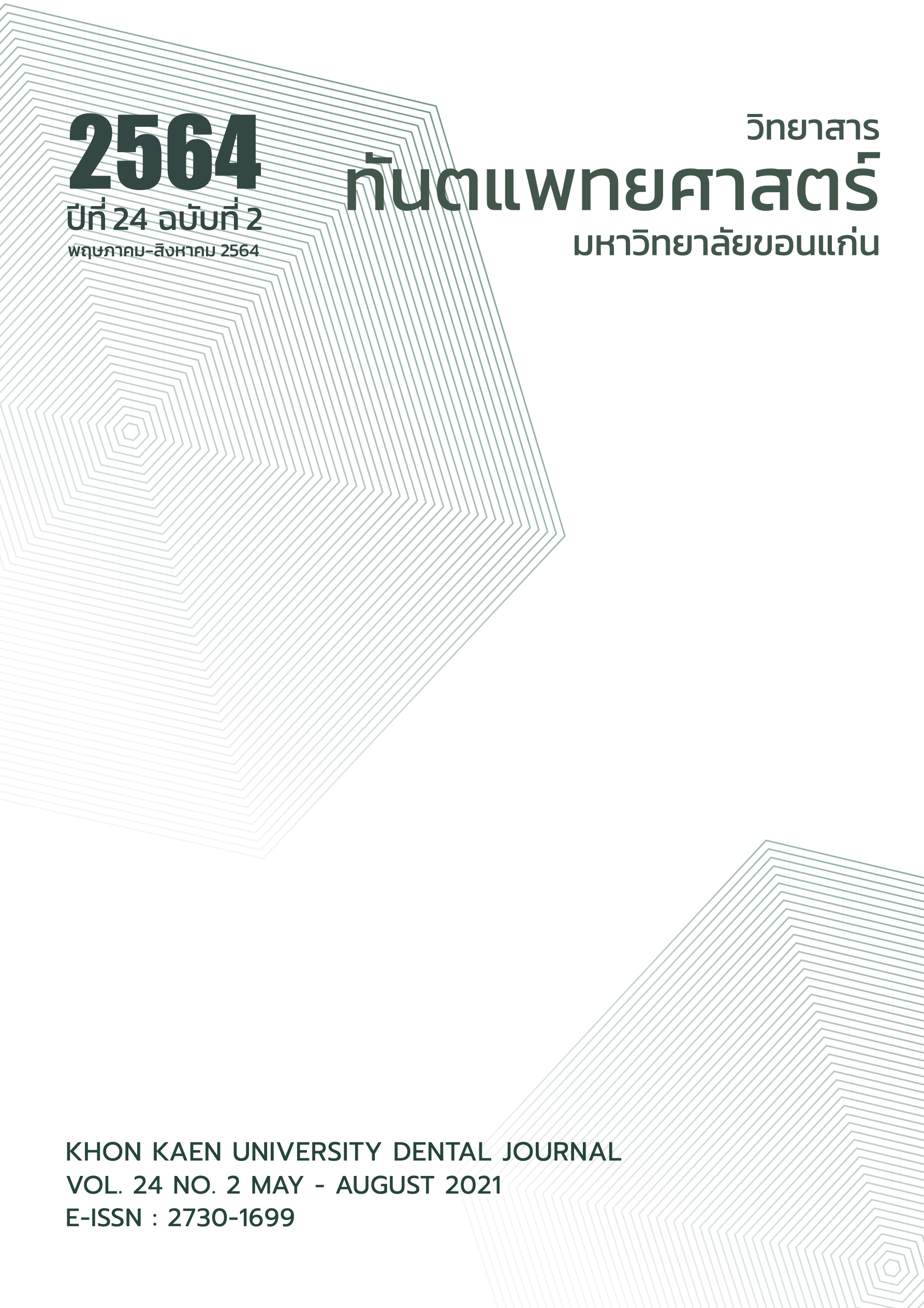The Use of Different Adhesives in Bonding Resin Composite to Resin Modified Glass Ionomer Cement
Main Article Content
Abstract
The aim of this study was to evaluate shear bond strength between resin composite and resin-modified glass-ionomer cement using different adhesives. Fifty cylindrical resin-modified glass-ionomer cement were prepared in dental stone mold and randomly divided in to 5 groups (n=10 for each group). Group 1 Optibond Universal), group 2 37% phosphoric acid and Optibond Universal, group 3 Optibond FL, group 4 Optibond S and group 5 Optibond XTR. A small plastic cylindrical tube (2 mm in diameter and 2 mm in height) was placed over resin-modified glass-ionomer cement, filled with resin composite and then light cured 40 seconds. All specimens were stored in distilled water for 24 hours. The shear bond strength test was performed using universal testing machine at a cross head speed of 0.5 mm/minute. The interface of fracture specimens was observed under stereo microscope to confirm mode of failure. Shear bond strength test results were statistically calculated by Kruskal-Wallis test. Mean shear bond strength for group 1, 2, 3, 4 and 5 were 29.67, 29.82, 31.30, 33.00 and 28.01 MPa respectively. There was no statistically different in shear bond strength between any groups (p>0.05). Mode of failure of all specimens were cohesive failure. In conclusion, all adhesive systems give no different in shear bond strength between resin composite and resin-modified glass-ionomer cement.
Article Details
บทความ ข้อมูล เนื้อหา รูปภาพ ฯลฯ ที่ได้รับการลงตีพิมพ์ในวิทยาสารทันตแพทยศาสตร์ มหาวิทยาลัยขอนแก่นถือเป็นลิขสิทธิ์เฉพาะของคณะทันตแพทยศาสตร์ มหาวิทยาลัยขอนแก่น หากบุคคลหรือหน่วยงานใดต้องการนำทั้งหมดหรือส่วนหนึ่งส่วนใดไปเผยแพร่ต่อหรือเพื่อกระทำการใด ๆ จะต้องได้รับอนุญาตเป็นลายลักษณ์อักษร จากคณะทันตแพทยศาสตร์ มหาวิทยาลัยขอนแก่นก่อนเท่านั้น
References
Ensaff H, O'Doherty DM, Jacobsen PH. Polymerization shrinkage of dental composite resins. Proc Inst Mech Eng H 2001;215(4):367-75.
McLean JW, Prosser HJ, Wilson AD. The use of glass ionomer cements in bonding composite resins to dentin. Br Dent J 1985;158(11):410-4.
Erickson RL, Barkmeier WW, Latta MA. The role of etching in bonding to enamel: a comparison of self-etching and etch-and-rinse adhesive systems. Dent Mater 2009;25(11):1459-67.
McLean JW, Wilson AD. Glass ionomer cements. Br Dent J 2004;196(9):514-5.
Loguercio AD, Alessandra R, Mazzocco KC, Dias AL, Busato AL, Singer Jda M et al. Microleakage in class II composite resin restoration: total bonding and open sandwich technique. J Adhes Dent 2002;4(2):137-44.
Andersson-Wenckert IE, van Dijken JW, Horstedt P. Modified class II open sandwich restoration: evaluation of interfacial adaptation and influence of different restorative techniques. Eur J Oral Sci 2002;110(3):270-5.
Mathis RS, Ferracane JL. Properties of glass ionomer/ resin-composite hybrid material. Dent Mater 1989;5(5):355-8.
Sidhu SK, Watson TF. Resin-modified glass ionomer materials. A status report for the American Journal of Dentistry. Am J Dent 1995;8(1):59-67.
Rusz JE, Antonucci JM, Eichmiller F, Anderson MH. Adhesive properties of modified glass-ionomer cements. Dent Mater 1992;8(1):31-6.
van Dijken JW, Kieri C, Carlen M. Longitivity of extensive class II open-sandwich restorations with a resin-modified glass-ionomer cement. J Dent Res 1999;78(7)1319-25.
Pamir T, Sen BH, Evcin O. Effects of etching and adhesive applications on the bond strength between composite resin and glass-ionomer cements. J Appl Oral Sci 2012;20(6):636-42.
Tate WH, Friedl KH, Powers JM. Bond strength of composite to hybrid ionomers. Oper Dent 1996;21(4): 147-52.
Arora V, Kundabala M, Parolia A, Thomas MS, Pai V. Comparison of the shear bond strength of RMGIC to a resin composite using different adhesive systems: An in vitro study. J Conserv Dent 2010;13(2):80-3.
Cuevas-Suárez CE, da Rosa WLO, Lund RG, da Silva AF, Piva E. Bonding performance of universal adhesives: an updated systematic review and meta-analysis. J Adhes Dent 2019;21(1):7-26.
Tay FR, Pang KM, Gwinnett AJ, Wei SH. A method for microleakage evaluation along the dentin/restorative interface. Am J Dent 1995;8(2):105-8.
Kerby RE, Knobloch L. The relative micro-shear bond strength of visible light-curing and chemically curing glass-ionomer cement to composite resin. Quintessence Int 1992;23(9):641-4.
Farah CS, Orton VG, Collard SM. Shear bond strength of chemical and light-cured glass ionomer cements bonded to resin composites. Aust Dent J 1998;43(2): 81-6.
Chandak MG, Pattanaik N, Das A. Comparative study to evaluate shear bond strength of RMGIC to composite resin using different adhesive systems. Contemp Clin Dent 2012;3(3):252–5.
Subrata G, Davidson CL. The effect of various surface treatments on the shear strength between composite resin and glass-ionomer cement. J Dent 1989;17(1):28-32.
Tanumiharja M, Burrow MF, Tyas MJ. Microtensile bond strengths of glass ionomer (polyalkenoate) cements to dentine using four conditioners. J Dent 2000;28(5):361-6.
Jorgensen KD, Iwaku M, Wakumoto S. Vacuum-mixing of silicate cement. Acta Odontol Scand 1969;27(5):453-65.
Mitchell CA, Douglas WH. Comparison of the porosity of hand-mixed and capsulated glass-ionomer luting cements. Biomaterials 1997;18(16):1127-31.
Mitchell CA, Douglas WH, Cheng YS. Fracture toughness of conventional, resin-modified glass–ionomer and composite luting cements. Dent Mater 1999;15(1):7-13.
Nomoto R, Mc Cabe JF. Effect of mixing methods on the compressive strength of glass ionomer cements. J Dent 2001;29(3):205-10.
Kaushik M, Sharma R, Reddy P, Pathak P, Udameshi P, Jayabal NV. Comparative evaluation of voids present in conventional and capsulated glass ionomer cements using two different conditioners: an in vitro study. Int J Biomater 2014;2014:935240.


